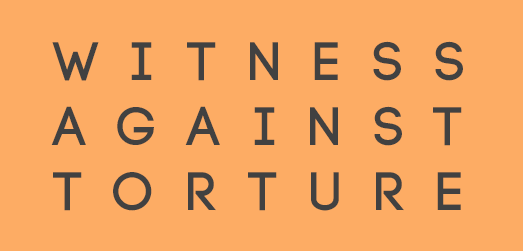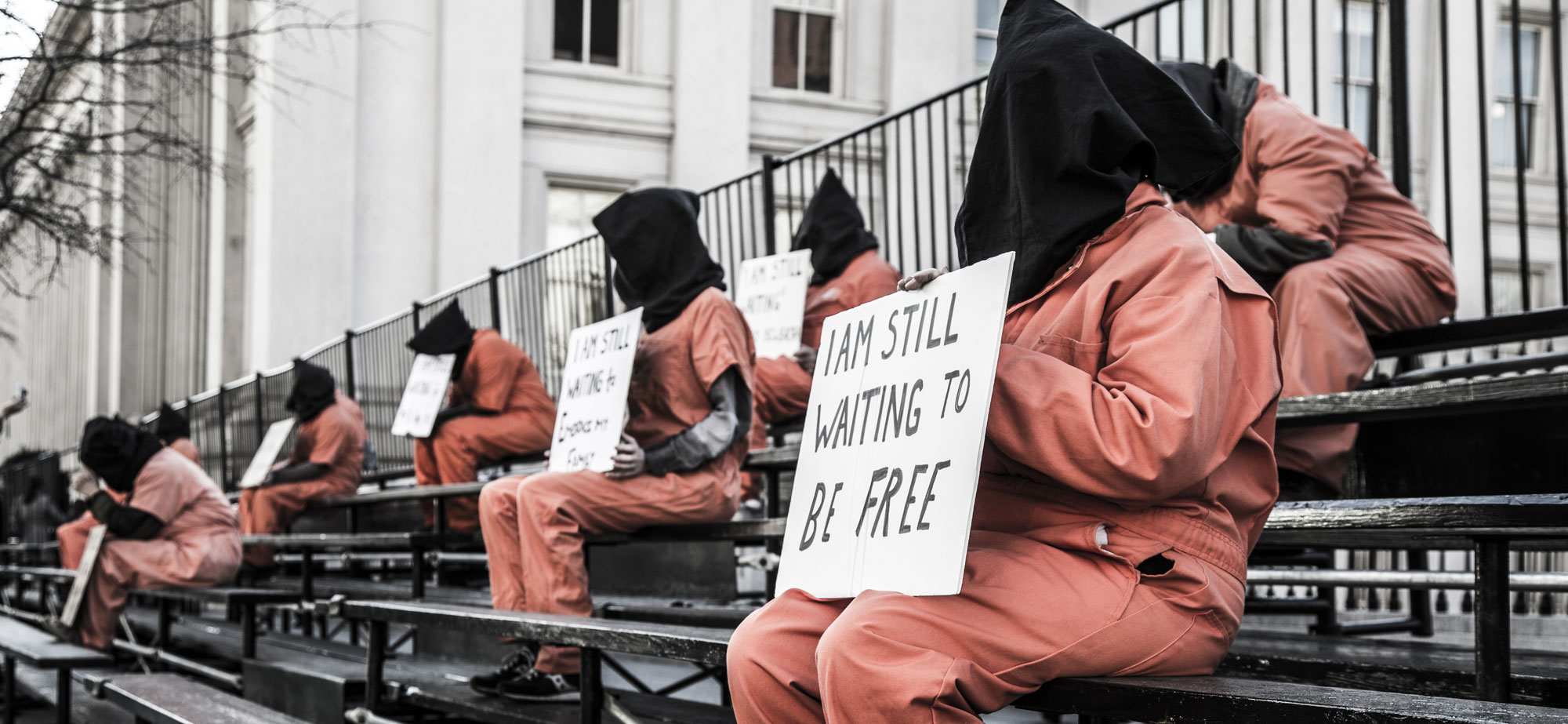From the Archive
Fast for Justice 2014: Days 6, 7
Dear friends,
We are in the process of recovering from a powerful day on January 11th, looking towards the breaking of our fast, and planning for the future. We continue to experience the power of community in a profound way. On January 11, we gathered with our WAT family and coalition partners, we brought the presence of the men imprisoned at Guantanamo into our midst, and in a beautiful, synergistic way, we were able to open our circle to join with a whole museum full of tourists, security guards, and park police.
And so today we entered into a full day of future-planning meetings with the renewed awareness of what is possible when we gather together in love and trust. We are grateful to each and every one of you for being part of this community.
Peace-
Witness Against Torture
In this Update
- The Price of Freedom Exhibit, by Erica B.
- An Open Letter to a Father at the National Museum of American History, by Ted
- Compilation of post-action reflections
- From Guantanamo to Immigration Jails in Tucson, by Dan W.
- A poem by Martin G.
- Invitation to join Friday Fast for Justice
Make Guantánamo History: Video & Photos
- 1:29 min version from Justin
- 3:00 min version from Johnny
- 10:00 min version from Ellen
- Extended footage from Palina
- Footage from Kennedy Center Shaker Aamer Action
- Photos from Witness Against Torture
- Photos from friends and allies
- ‘12 years too many’: US activists mark Gitmo anniversary by rallying for closure
The Price of Freedom Exhibit
by Erica B.
My hands were shaking as I tried to pin my sign “Force Feeding is Torture” onto the front of my orange jumpsuit. Helen, Becky, Marie and I were all shaking pinning signs as we stood together in a bathroom stall on the third floor of the National Museum of American History. We had gotten the go ahead earlier from Luke N. and now were getting ready to make our exit, hooded, with heads down and hands behind our backs to become a new exhibit in The Price of Freedom: Americans at War. Marie led us; I was the last in line. We walked out breathless and with our hearts beating rapidly and took our places in the exhibit to help make Guantanamo history.
Carmen’s familiar voice started immediately. As he spoke to the audience a security guard rushed over and hurriedly removed the hoods from our heads. Immediately, surrounding security began the close the exhibit and ask people to move downstairs into the demonstration in the Atrium. I could hear the singing and mic-checking and my heart filled with joy. Meanwhile, our exhibit was closed but we stood waiting, put our hoods back on, and settled in for whatever might happen next.
Before the action I imagined myself walking out of the bathroom with my hood on and being grabbed by security and arrested immediately, never to become part of the exhibit we had so carefully planned. The reality was nothing that I had thought could happen before I walked into the doors of the museum that afternoon. The head of security along with a Parks Police officer came up to our floor and explained to Carmen that we were allowed to stay until 5:15pm when they began closing the museum. I could hear the emotion in Carmen’s voice as he thanked them and shook their hands.
I was in disbelief. I was proud of the security guard for making the decision he did as now Carmen could speak truth and we could stand and represent the men suffering at Guantanamo. A looped tape of the horrifying grind of war sounds—trumpets and gun shots–played above our heads as a part of the museum’s exhibit. For almost three hours we held steadfast and vigiled as the sounds of war tape played above us at times I felt it was mocking me and my promise to endure standing or kneeling with my face covered, unable to see or hear anything that our audience might be saying. When I needed a breath I would turn around and lift my hood for a few seconds. Behind me printed on the cloth that wrapped the entrance of The Price of Freedom: Americans at War exhibit were the faces of a group of Native Americans posed with rifles. I thought of their slaughter and that image refocused my mind. I took a deep breath and put the hood on again to continue our vigil to make Guantanamo history.
My part was small in the events that unfolded on the grey, rainy afternoon of January 11 in the National Museum of American History. I’m so thankful for everyone in Witness Against Torture, for the museum staff and security, and to the patrons of the museum. I know some of them went home that night and talked about what they saw with their friends and family and as Mike B. pointed out during our reflections later in the day, we sparked conversation not only in DC but among thousands around the world. I feel hopeful, but the prison remains open so our work is not done.
An Open Letter to a Father at the National Museum of American History
by Ted
January 12, 2014
Dear Friend,
Yesterday you approached us in the atrium of the American History museum, asking how long we planned to have our “exhibit” on Guantánamo. I replied, “We hope it is permanent.”
When you approached, the main part of our demonstration was transitioning from the singing and announcement of our purpose to the duration of the living exhibit, of which I was not directly a part. I was in the museum with my wife, my mom, and little Esther sitting on shoulders, and heard you say that the Guantanamo presence was disruptive to your day with your family.
My mom had the loving awareness to ask you, “What are your thoughts about Guantánamo?” You explained that you did agree with us that the detention center should be closed. I imagine what you wanted was a day with your family visiting the museum, and this was precious time for you. The museum guards, you informed us, were beginning to close the museum.
I couldn’t help but think about the fact that all the men in Guantánamo really want is the same thing that you and I wanted, and were able to have: to be with our families. They have been wanting this for twelve years. And yet they still face indefinite detention.
What neither of us could have predicted was that, ten minutes after you had departed, the museum staff reopened all the exhibitions – allowing our Make Guantánamo History living exhibit to remain in the midst of it all! My wife and I went upstairs to find a friend speaking out in front of the dramatic entrance to the Price of Freedom exhibition. Beside him knelt four hooded detainees. “Downstairs,” Carmen said, “is a display for the Greensboro lunch counter civil rights protest. That is the true price of freedom. What you have behind me in this museum exhibit, what we have here with the Guantánamo detainees, is the cost of war.”
In my re-imaging of how our conversation could have gone, I imagine our conversation lasting long enough for us to receive word that the museum was reopened. I imagine how both our families could have met, shook hands, and then proceeded together up the escalator to the exhibition that you wanted to see.
Then together we each could have understood, in a more authentic way, what we had already agreed upon – yes, Guantánamo should be closed. And then, I believe, we would have also agreed that Guantánamo needs to be displayed in this museum – right there before us in plain sight, in fact. It is, sadly, American History, an essential part of our present shared story. And it needs to be remembered by all who visit this museum so that such prisons like it, worse than it even, must also be closed, never to be created again. I imagine us witnessing together a living history, a turning point.
Compilation of post-action reflections
After the action at the American History Museum we met at St Stephens and shared our reflections and reactions. Below is some of what was said in our circle:
Mike – We create art by doing this. Our actions are not just a message of justice, but a message of justice that comes THROUGH US. Still have questions about when the sun rises for these men.
Chantal – totally worth traveling over 4000 miles from Anchorage just for this. To experience something embodied. We were planting seeds. I saw some minds start to change.
Amanda – reaction to the exhibit was YES, it BELONGS there. The paradox of making it “history” and also “making history.”
Emily – I find myself acting like someone from a police state – okay, look around, where are they? Then today… they’re letting this happen? Am I in the USA 2014 right now?! Wouldn’t have happened without us, and wouldn’t have happened the way it did without them.
Emanuel – never felt rain was against us but with us. Discouraged by the comment, “No, I read my history in books” in refusing a pamphlet. But there is a group of people who don’t READ history but instead LIVE history.
Frank – the heartfelt place we came from, the humanizing element. Little boy looking down into 2nd floor and up into my face. That will be that kid’s experience of the museum.
Mike B – The beginning was overwhelming! People must have thought, “Everyone in America is against this prison, I had no idea!” Comments may have been negative, but conversations were always thoughtful. Renews my hope. I’m sure there are 100 people in DC having conversations about this because of today’s action, 1000, 10,000 people around the country and world.
Carmen – a flutter went through the museum like through a stadium. “Well we know it closes at 5:30, but we won’t stay later than that.” Very magical for them to say, you can stay. Almost cried – I’m not going to jail!
Art – each action for the last nine years, an experiment in truth. Looking out for one another. How do we go deeper? Best solidarity we know how to do. If we didn’t do this today, I wouldn’t be as mindful as I know I need to be. Space was transformed, I was transformed.
Jeremy – numbers were great. Robust and increasing diversity. People look to us for unwavering moral purpose. People attach to us and take it back to their own communities. Our family part of a larger family. Coalition. We brought the spirit of occupy into that space. We bend it to our moral will. A sense of the publicness of public institutions in DC, it made me feel, “This couldn’t happen in Russia or China.” And I rarely have that thought. Now how do we get this to move policy, the military, the law.
Sarah M remembered how Matt said before the action, when someone asked which authority had jurisdiction over the museum: “All I know is that today, WE have jurisdiction.”
From Guantanamo to Immigration Jails in Tucson
by Dan W.
Activists fasted for 7 days, and gathered on January 11th in Tucson, AZ, where this reflection was shared:
“It is national security. This is the coat hanger the government uses to suspend all of these rights. It is always a matter of national security.”
As we read these words in front of the Federal Courthouse in Tucson AZ I was shocked at how true they resonated with where we were. While about fifteen of us held signs outside of the courthouse to remember the anniversary of Guantánamo Bay, we were also there to protest one of the ways Guantánamo has come home. Every day in Tucson AZ, and throughout the southwest, seventy men and woman shackled hand and wrist, still dirty from their dangerous journey in the desert undergo a sham trial. In about two hours they undergo an immigration legal counseling session with a lawyer, an initial appearance, trial, and sentencing. At the end of this unconstitutional trial they receive a felony re-entry charge and anywhere from thirty days up to ten years in a privately owned jailed. This process is known as Operation Streamline.
Should anyone try to apply for asylum or some other kind of legal residency in the U.S., they are forced to stay in detention for the duration of their court proceedings, a process that takes years. Immigration Customs and Enforcement does release individuals on bond; however, they can deny bond to any individual, or, more often, set them at an unattainable price: six thousand dollars up to sixty five thousand dollars. Unable to pay their bond, and unable to go back to their country of origin for fear of persecution, it is not uncommon for people to stay in these detention centers for years. One man we are in contact with has been held for thirteen years with no end in sight.
This process happens to thousands of individuals everyday. Often, we ask ourselves why. Why would the Government indefinitely detain innocent, non-violent men and woman? Why would it clearly violate due process and its own constitution on a daily basis?
Our answer has most recently come from Shaker Aamer, held in Guantánamo. For the sake of national security we lock up these “illegals” in the same way we lock up “terrorists.” With the justification that if they were ever released they would immediately seek to harm us.
From doing work with Witness Against Torture, I learned the real danger of Guantánamo is not only the harm it is doing to the men detained there in the prison, but the harm it is doing to the American justice system. The passing of the 2012 NDAA was the most blatant example of this. However, the culture of “prevention by detention” and destruction of Habeus Corpus and due process which has borne and sustained Guantánamo have also created Operation Streamline and the oppressive network of immigration detention centers. The culture of torture can also be seen in the terrible conditions with which Border Patrol treats those in custody. The majority of people detained report either being physically, mentally, or sexually abused, being placed in ice cold cells, being forced to maintain stress postures, and being denied food and water.
The torture continues at the detention centers where inmates are often put on “lockdowns,” in solitary confinements, and issued disciplinary write ups for things like “not making a bed.” Additionally, the U.N. classifies indefinite detention as torture.
Guantánamo must close, and it will not close without our protests and our actions. However, we must not close one Guantánamo only to forget about the hundreds of other Guantánamos it has spawned and the hundreds of thousands men and women still trapped inside them.
A poem
by Martin G.
The experience is disorienting, as you might expect from the description:
days without eating,
walking on thin ice with,
you suspect,
deeply flawed strangers.
You are in a chair, breathing, awaiting a scheduled boost, pain and nourishment.
Here is the transcript, redacted,
background radiation from Camp Echo,
fingers pointing at the moon.
Invitation to join Friday Fast for Justice
As WAT’s Fast for Justice and rolling fast of the past ten months comes to a close, we are mindful of the 155 men who remain at Guantánamo. We feel compelled to continue a form of fasting in solidarity with those who continue to hunger for justice at the prison. Therefore, we are re-initiating the Friday Fast for Justice and extending an invitation to anyone who would like to participate.
We are asking individuals who sign up to fast– in any form they like—on Friday, to make three phone calls, and to write a letter to a prisoner at Guantánamo. On the day you fast we highly encourage you to take a photo of yourself holding a sign indicating that you are fasting AND/OR to write just a couple of sentences reflecting on the day’s experience. Send the photo or brief reflection to witnesstorture@gmail.com, or post it directly on our Facebook page. Please include where you live, and if you comfortable sharing it, your age. WAT would like to be able to use the photo and/or reflection on our twitter and Tumblr. For samples of reflections you can visit CloseGitmo.net. These photos and reflections are a reminder to us all that we do this important work for our brothers at Guantánamo and their families in community.
PLEASE E-MAIL witnesstorture@gmail.com if you are interested in participating in the Friday Fast for Justice. You can commit to fast weekly for a particular time period, or till Guantánamo is closed. After you sign up to participate, you will receive an email with the details about making the phone calls and writing a letter.



Join us on social media